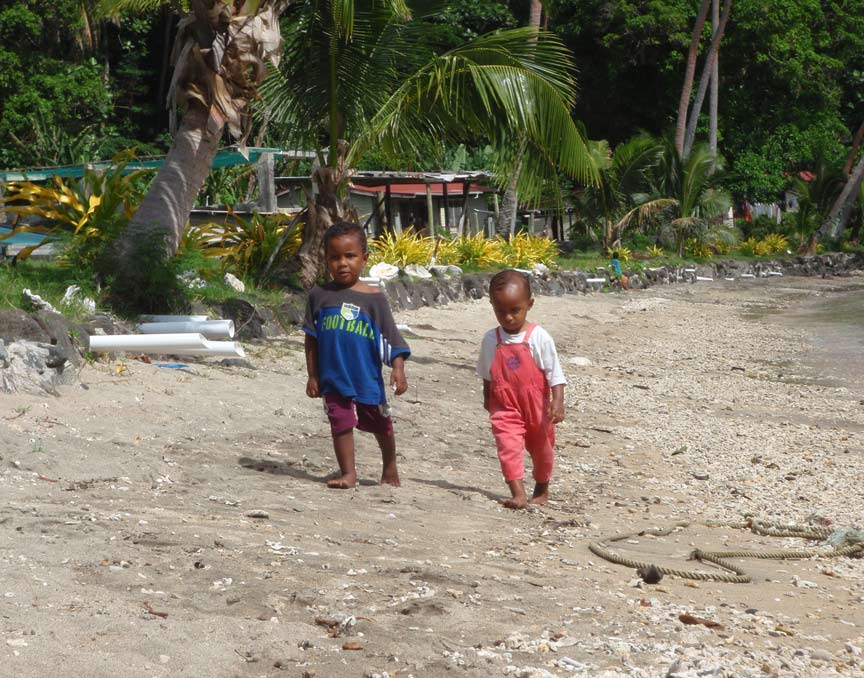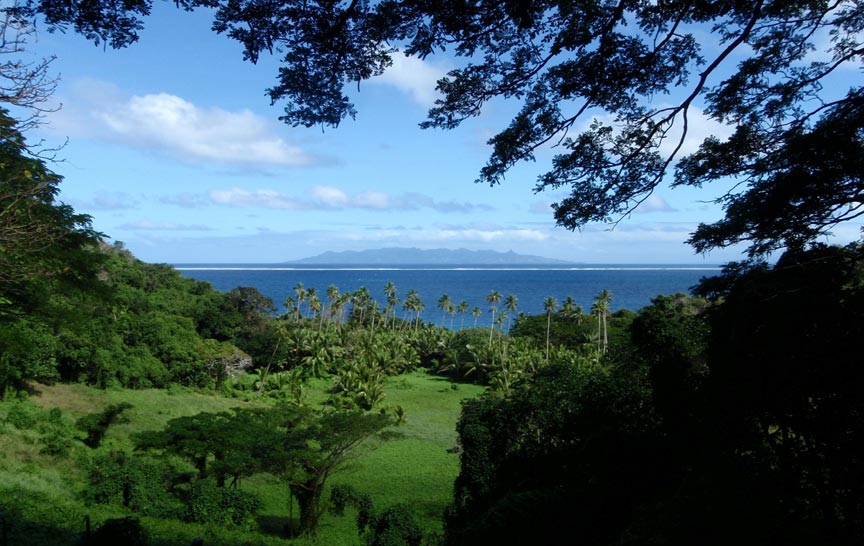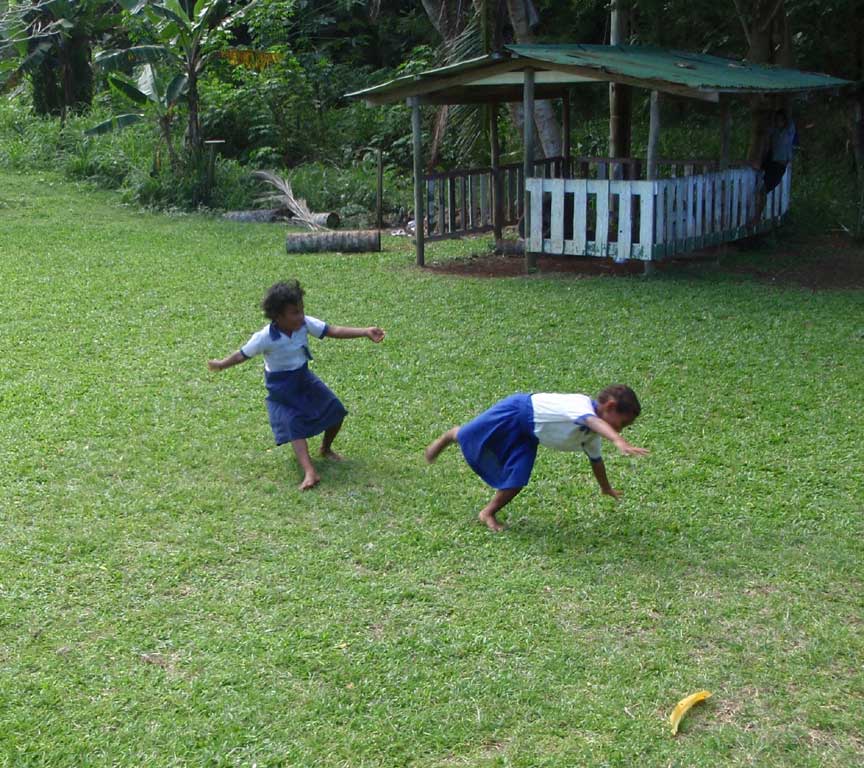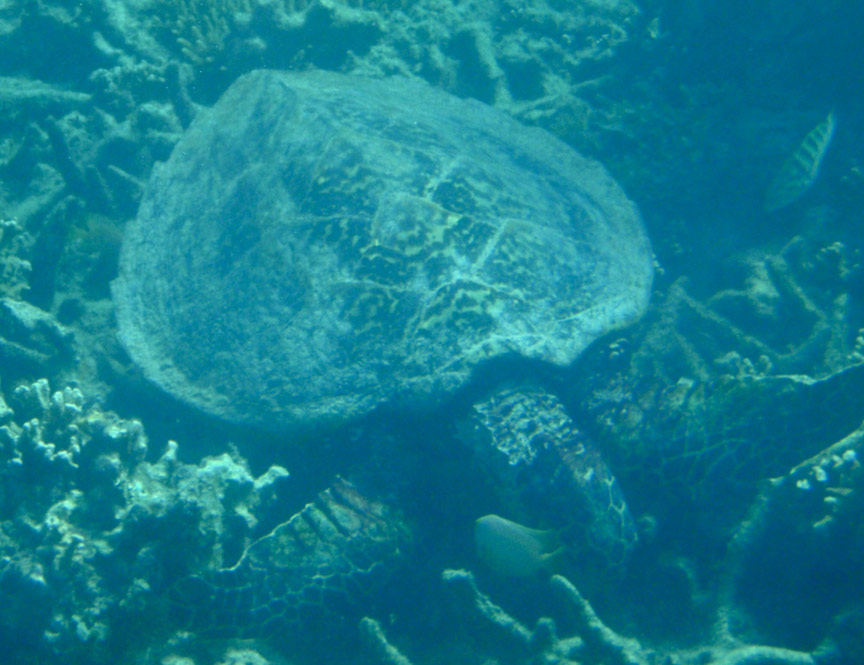Lepers, Giant Clams and a Turtle - Makogai Island, Fiji

Harmonie
Don and Anne Myers
Tue 28 Jul 2009 01:49
|
17:26.484S 178:57.121E
We did leave Savusavu (not to be confused with
sevusevu, Somosomo, sulu or Suva) as planned on July 13th. After an
overnight stop off the coast of the Cousteau resort (again), we set off for
Makogai Island, which is about sixty miles to the south of Savusavu and the big
island of Vanua Levu. It was a murky day with light winds. Perfect
for fishing. Perfect because we are told the kind of fish we like to
eat are more likely to come to the surface in murky light, and light winds
mean the boat will be semi-stable for those tasked with killing, chopping
heads off, gutting, filleting and skinning the fish (Don). We caught one
mahi-mahi while motorsailing at 6ish knots; which is the speed, we are told,
best suited for mahi-mahi catching. We then caught another one while
sailing at 8ish knots. So much for that particular boat speed/fish
catching old wives tale. Both mahi-mahi were apparently kicked out of
triple back flip, double twisting freedom move school as neither put up that
much of a fuss when Don brought them aboard. Picture 1 shows the first
mahi-mahi caught. She turned from her normal iridescent blue to this
sparkly yellow once she hit the deck. Don didn't give this or the next one
a chance to display a rainbow of colors as he chopped them up pretty darn
quick. We saved out enough to feed six and put the rest in the
freezer. The freezer is nearly bursting with stuff as we are stocking up
for the arrival of our niece and nephew. Our nephew, a six-plus foot tall
23 year old, has already warned us that he eats a lot. We figure he'll be
fine. We'll just station him up on the bow with a stalk of bananas and a
tub of mahi-mahi. That ought to carry him through a day or
two.
We arrived at Makogai Island around three that
afternoon and decided it was best to go ashore and get through the sevusevu
ceremony as quickly as possible. Sue, Jackie and I dressed
appropriately in skirts with knees covered and the entire group ditched hats and
sunglasses (all considered disrespectful) for the occasion. Chief
Kimeli (sp?) met us on the beach and directed us to a sitting spot (plank of
wood supported by a few rocks) outside his small wooden frame house. We
introduced ourselves and offered him the kava root. He accepted, said a
few things in Fijian and that was that.
We knew before coming that the island used to be a
leper colony. The chief confirmed this saying the last lepers were taken
off the island in 1969 and transferred to an institution on the big island of
Viti Levu. Previous to this, hundreds of lepers lived on the island -
native Fijian lepers lived separately from Indo-Fijian (Indian) lepers and all
were cared for by a group of nuns and doctors. Over the course of the
sixty or so years the island was used as a leper colony, over 1,000 people died
and were buried there. The chief said the graveyard is now
overgrown. The current villagers never go there as they believe the
leper's ghosts pretty much rule the place and they have no desire to mess with a
bunch of leper ghosts. Aside from the overgrown graveyard, all that
remains of the leper colony now is the ancient infrastructure (a generator circa
1906 that is still used for three hours each evening after dark, scary looking
power lines and a semi-road through the forest connecting the two small
villages), a few stone structures including the remains of an outdoor cinema and
the stone staircase leading to the women's dorm (the rest of the stone building
was disassembled by scavengers after the leper colony was closed
down).
After 1969, the island was briefly used for a sheep
farm. Sheep don't take too kindly to the tropics, even sheep supposedly
bred for the tropics, and the sheep farm didn't last long. After that the
Australians came in with some money to start a giant clam farm. Yup, giant
clams. As in three feet long. The idea was to cultivate the giant
clams in the bay near the village and then transfer (sell) them to Fijian
resorts where they would be used as a tourist attraction (for diving and
snorkeling tourists). Chief Kimeli arrived on Makogai Island about the
time the giant clam farm was started up. He was trained by an Australian
and then took over the endeavor. At the moment the funds for the giant
clam farm have dried up due to the politics associated with the recent military
coup in Fiji and Australia's displeasure with it. It's not clear what this
means for the four families that live in Chief Kimeli's little giant clam farm
realm.
Picture 2 - Our view of Chief Kimeli's village
and some of the leper colony remains as seen from the boat.
Picture 3 - Our view of Lady Kay and the reef
connecting Mokogai Island with the tiny island to the north.
Picture 4 - Village kids that greeted us when
we came ashore.
Picture 5 - Chief Kimeli explaining the
history of the island to us as he sits on the stairs that used to lead up to the
leper colony's dormitory for women.
Picture 6 - Giant clams. One open, one
shut. Both sitting on the bottom of the bay about 12-15 feet down.
Both about three feet long, although it's difficult to tell their size from the
picture.
Picture 7 - After we got back from the
sevusevu ceremony and brief tour of the village and leper colony remains, it was
time for mahi-mahi dinner for six on Harmonie. I'm working in
our spacious galley as John from Storyteller looks
on. On the other side of the island, there is another
slightly larger village, and a school. There are 28 school-age children on
the island and they all attend one very small school. The eight children
from Chief Kimeli's village walk 2 1/2 miles to and from the school every
day. That's five miles a day. Up hill both ways. Truly, it
is. We know because we did it. The 'road' that runs from Chief
Kimeli's village to the village with the school is a rugged 2 1/2 mile walk that
skirts the hilly coastline of the island. The day we visited the
school, the husband and wife teacher team was busy getting some of the kids
ready for a Fiji-wide standard test the next day. If tension can be high
on a tiny Fijian island, then the tension was high for the teacher team.
The kids didn't seem overly concerned about the test, but the husband half of
the teacher team admitted it was a pretty big deal.
The husband and wife teacher team was from Suva
(Fiji's capital city) and were stationed on Makogai Island for a two year
term. It wasn't clear whether they viewed this as a prison sentence or a
vacation. They were both too professional to let on either way.
Their lifestyle on the island is no picnic. Like the villagers, they have
to grow their own fruits and vegetables for food because there is no supply
ship, no grocery store, no nothing. Each of the two villages has a small
(maybe 15 foot) open aluminum boat with an outboard motor that they use to get
to the main island for supplies. They do this over about fifteen miles of
open ocean. A 15 foot open aluminum boat in the open ocean. You
couldn't pay us enough to risk our lives like that. One of the villagers
did say that one of the boats capsized a few months ago and a six-month old baby
was drowned. He relayed this story in a matter -of-fact manner
with little or no emotion shown. Maybe he was just being
polite and didn't want to over dramatize the incident in front of strangers like
us who spend our lives on boats. Hmmmm.
The teachers were not only concerned about
the standard test the kids had to take the next day, but their other top
priority seemed to be the installation of a new giant green plastic water
tank. As the wife half of the husband and wife teacher team explained, 'We
have no water to flush the toilets with', this said while waving in the general
direction of what looked like a row of outhouses, but what must have been a row
of toilets all housed in one structure with a separate door leading to each
toilet. 'Once we get the new water tank installed, we will be able to
flush the toilets without having to carry water.' When she said 'install
the water tank', she meant she, her husband and the kids. Some of the kids
that weren't studying for the test were working together to mix cement for the
tank base. They were doing it themselves. Of course, right?
It's not like they could have called 1-800-toiletflushingwatertankinstallers or
anything. Some of the really small kids weren't studying for the test or
mixing cement, they were impressing us with their ability to turn
cartwheels. One of these cartwheel turning girls is the youngest in the
school (5ish years old) and she is one of the eight kids that make the 2 1/2
mile trek to school and back each day. We thought it was impressive that
she still had the energy to turn cartwheels after the 2 1/2 mile trek.
None of us were cartwheeling after our trek.
Picture 8 - One of the marvelous views
we experienced during the 2 1/2 mile walk from Chief
Kimeli's village to the village on the other side of the island with the
school.
Picture 9 - Mokagai Island School. There are
two classrooms, one office and a kitchen. That's the row of currently
non-flushing toilets to the left of the school building.
Picture 10 - A blackboard in one of the school
rooms. Note that everything is written in English and that one of the math
problems asks, 'Mr. Prasad planted 56 cabbage seedlings in one row. How
many seedlings did he plant if there were 48 rows of cabbage?' We thought
this was particularly appropriate as all the villages in Fiji grow their own
vegetables and cabbage is one of their staples. We know because we've
eaten cabbage salad going on four nights in a row now. Very useful,
cabbage is. I never realized this until just this year. The stuff
will keep in the fridge for weeks if housed in the proper green food storage
bag. And it can do everything lettuce can do and then some. Hail to
the almighty cabbage. Glad to see the Fijian kids are learning long
multiplication based on cabbage related problems.
Picture 11 - Highly energetic cartwheeling school
girls showing off for us.
We stayed in the bay with Lady Kay and Storyteller
at Makogai Island for three nights. Aside from the trek to the school, we
did a fair amount of snorkeling to see the giant clams and other
assorted life under the sea. We did see more of the brilliant blue
starfish that were so popular in Tonga, we also saw our first sea
serpent. The really venomous kind with wide bright white and
black bands. Luckily these nasty snakes have small mouths that can't
really take a chunk out of a human. On top of that we are told they are
basically shy. The one we saw was making its way along the sea bottom
looking for its next victim. The two of us weren't even on its
radar. Even so, I didn't hang around above it long enough to take a
picture. The highlight of our underwater sightseeing at Makogai was a sea
turtle so intent on chomping down a fish that it didn't even notice the two
giant humans floating above it snapping pictures with a flash. It
wasn't until I kicked with my flippers to get a better camera angle
that the turtle realized what was going on. He was out of there in a
flash. Literally. Sea turtles can scoot through the water like
there is no tomorrow. This one was out of camera range in less
than half a second.
Picture 12 - Some of our favorite little
zebra-looking fish hanging around a solitary coral sprout.
Picture 13 - Sea turtle chomping on a
fish.
More on our Fijian island adventures
later.
Anne
|












